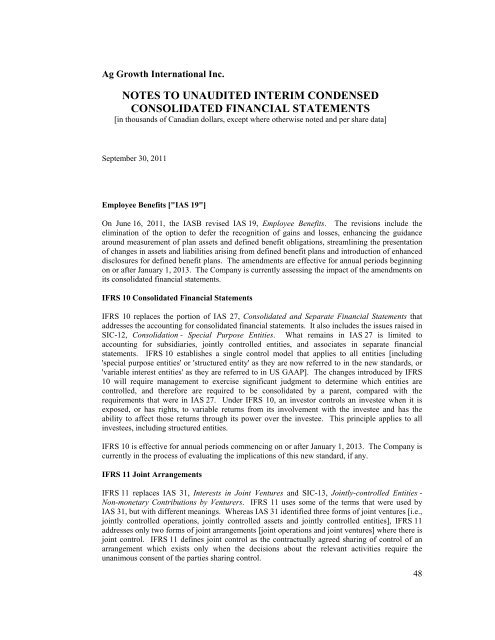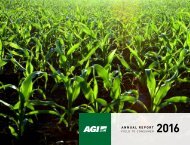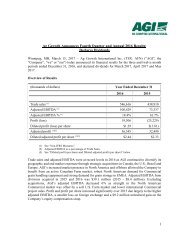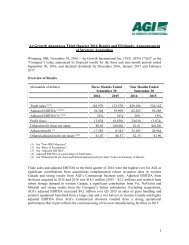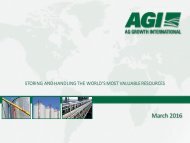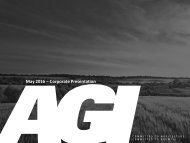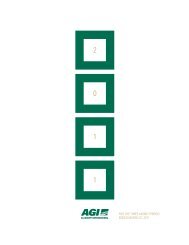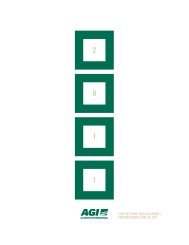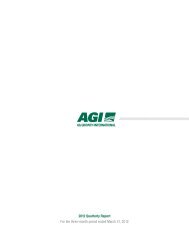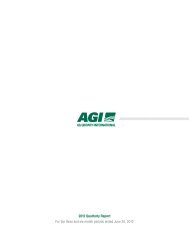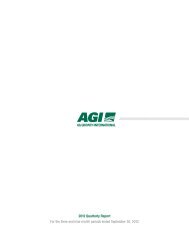Q3 Financial Report - 2011
Create successful ePaper yourself
Turn your PDF publications into a flip-book with our unique Google optimized e-Paper software.
Ag Growth International Inc.<br />
NOTES TO UNAUDITED INTERIM CONDENSED<br />
CONSOLIDATED FINANCIAL STATEMENTS<br />
[in thousands of Canadian dollars, except where otherwise noted and per share data]<br />
September 30, <strong>2011</strong><br />
Employee Benefits ["IAS 19"]<br />
On June 16, <strong>2011</strong>, the IASB revised IAS 19, Employee Benefits. The revisions include the<br />
elimination of the option to defer the recognition of gains and losses, enhancing the guidance<br />
around measurement of plan assets and defined benefit obligations, streamlining the presentation<br />
of changes in assets and liabilities arising from defined benefit plans and introduction of enhanced<br />
disclosures for defined benefit plans. The amendments are effective for annual periods beginning<br />
on or after January 1, 2013. The Company is currently assessing the impact of the amendments on<br />
its consolidated financial statements.<br />
IFRS 10 Consolidated <strong>Financial</strong> Statements<br />
IFRS 10 replaces the portion of IAS 27, Consolidated and Separate <strong>Financial</strong> Statements that<br />
addresses the accounting for consolidated financial statements. It also includes the issues raised in<br />
SIC-12, Consolidation - Special Purpose Entities. What remains in IAS 27 is limited to<br />
accounting for subsidiaries, jointly controlled entities, and associates in separate financial<br />
statements. IFRS 10 establishes a single control model that applies to all entities [including<br />
'special purpose entities' or 'structured entity' as they are now referred to in the new standards, or<br />
'variable interest entities' as they are referred to in US GAAP]. The changes introduced by IFRS<br />
10 will require management to exercise significant judgment to determine which entities are<br />
controlled, and therefore are required to be consolidated by a parent, compared with the<br />
requirements that were in IAS 27. Under IFRS 10, an investor controls an investee when it is<br />
exposed, or has rights, to variable returns from its involvement with the investee and has the<br />
ability to affect those returns through its power over the investee. This principle applies to all<br />
investees, including structured entities.<br />
IFRS 10 is effective for annual periods commencing on or after January 1, 2013. The Company is<br />
currently in the process of evaluating the implications of this new standard, if any.<br />
IFRS 11 Joint Arrangements<br />
IFRS 11 replaces IAS 31, Interests in Joint Ventures and SIC-13, Jointly-controlled Entities -<br />
Non-monetary Contributions by Venturers. IFRS 11 uses some of the terms that were used by<br />
IAS 31, but with different meanings. Whereas IAS 31 identified three forms of joint ventures [i.e.,<br />
jointly controlled operations, jointly controlled assets and jointly controlled entities], IFRS 11<br />
addresses only two forms of joint arrangements [joint operations and joint ventures] where there is<br />
joint control. IFRS 11 defines joint control as the contractually agreed sharing of control of an<br />
arrangement which exists only when the decisions about the relevant activities require the<br />
unanimous consent of the parties sharing control.<br />
48


